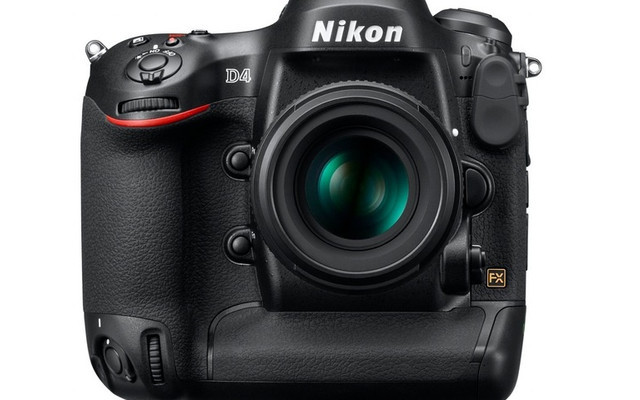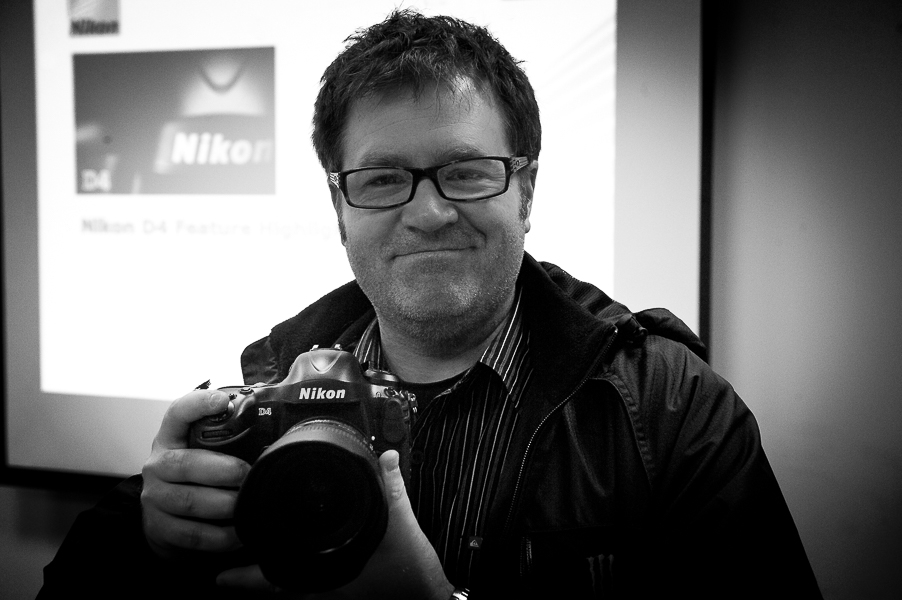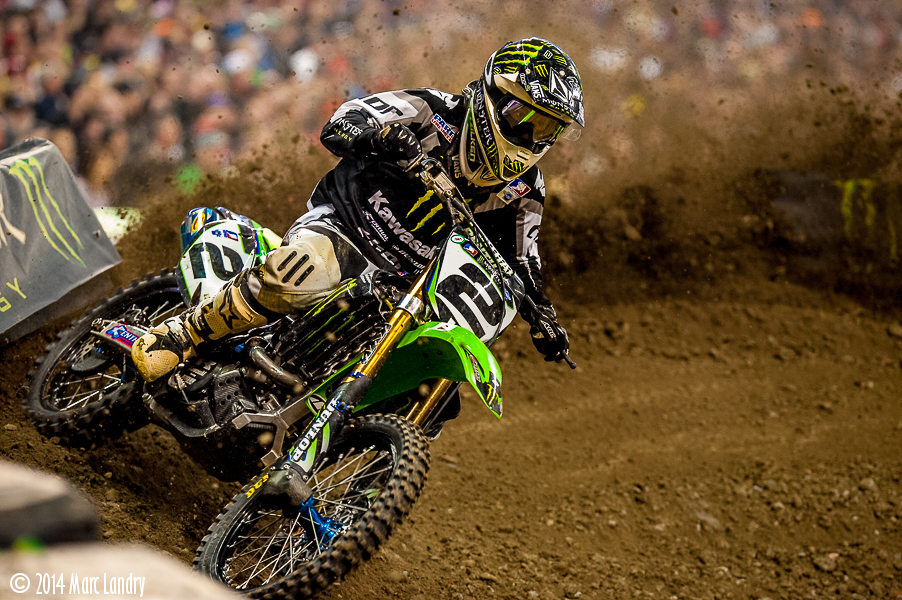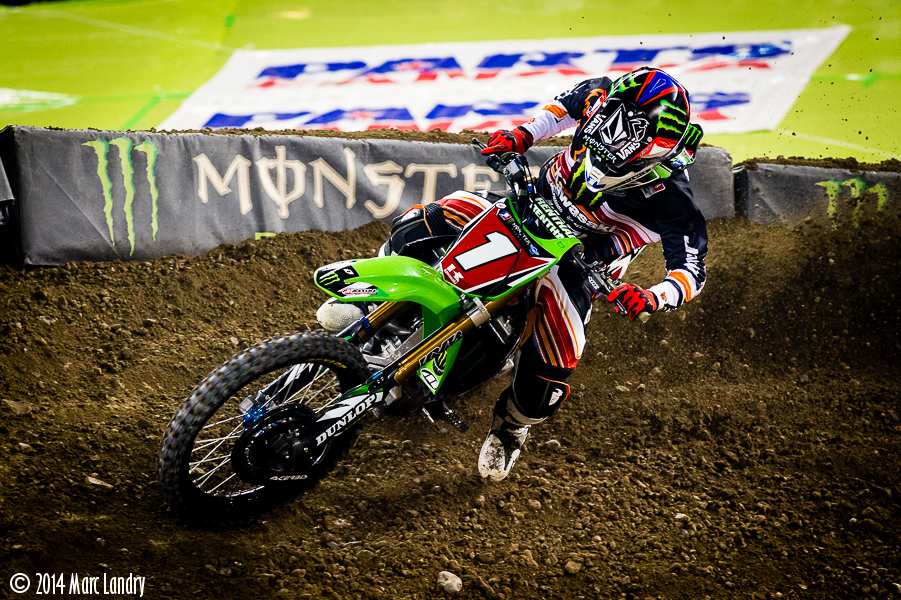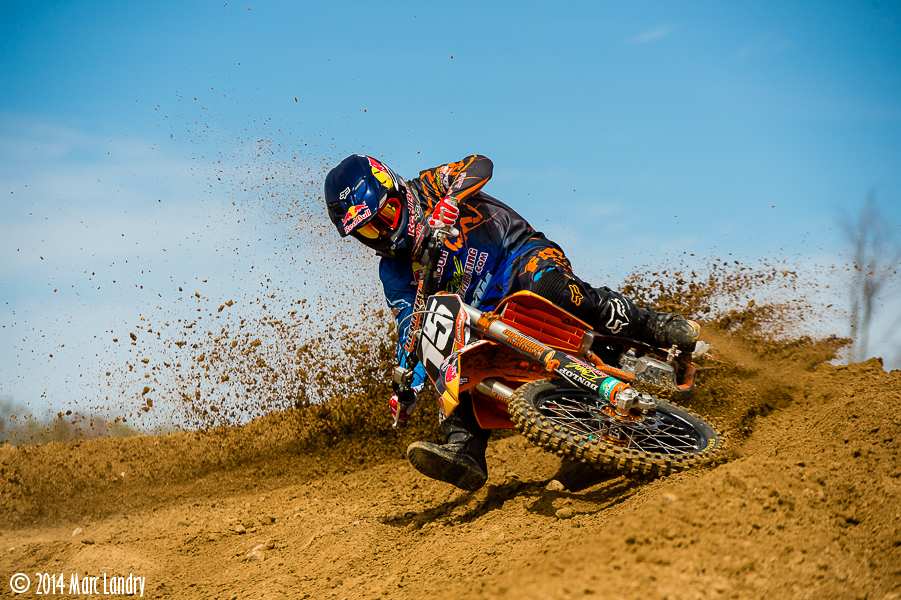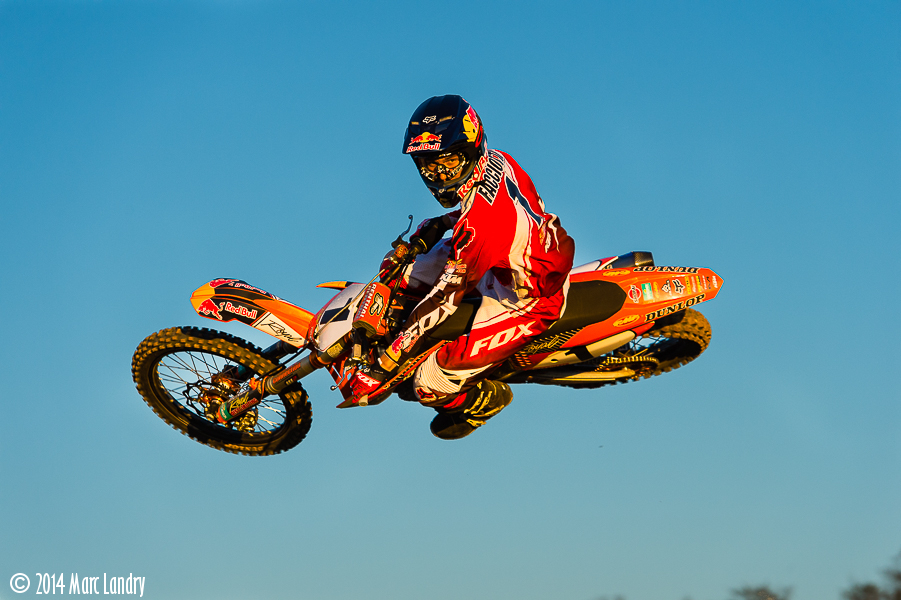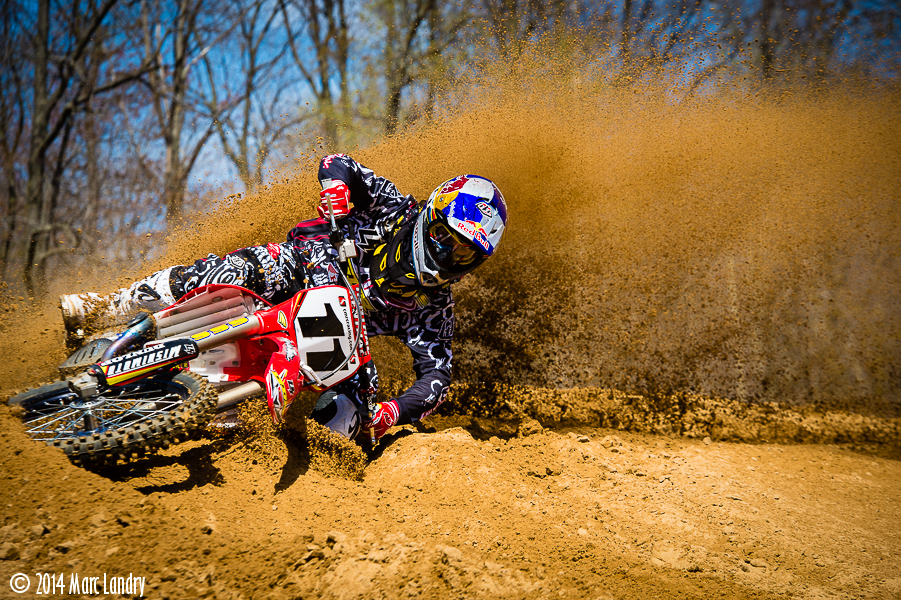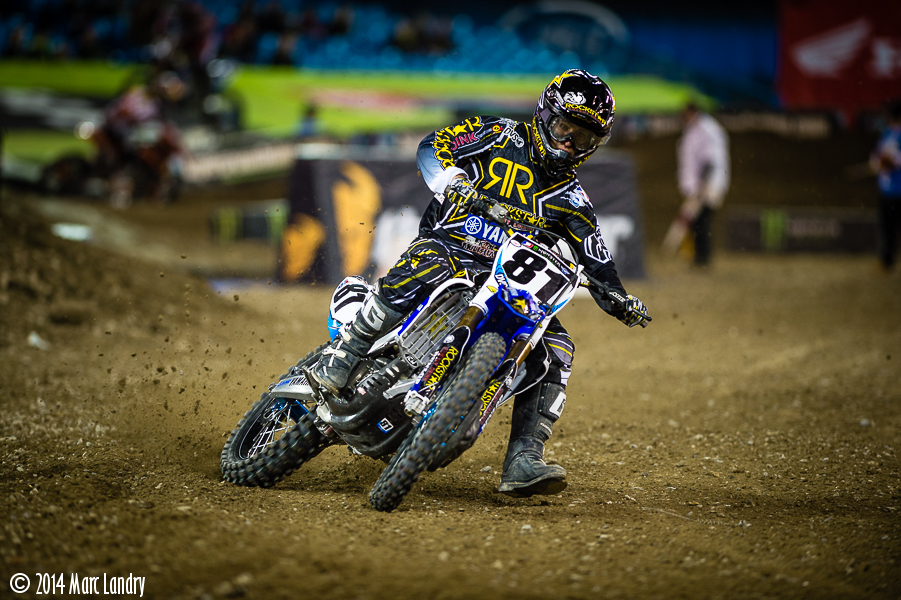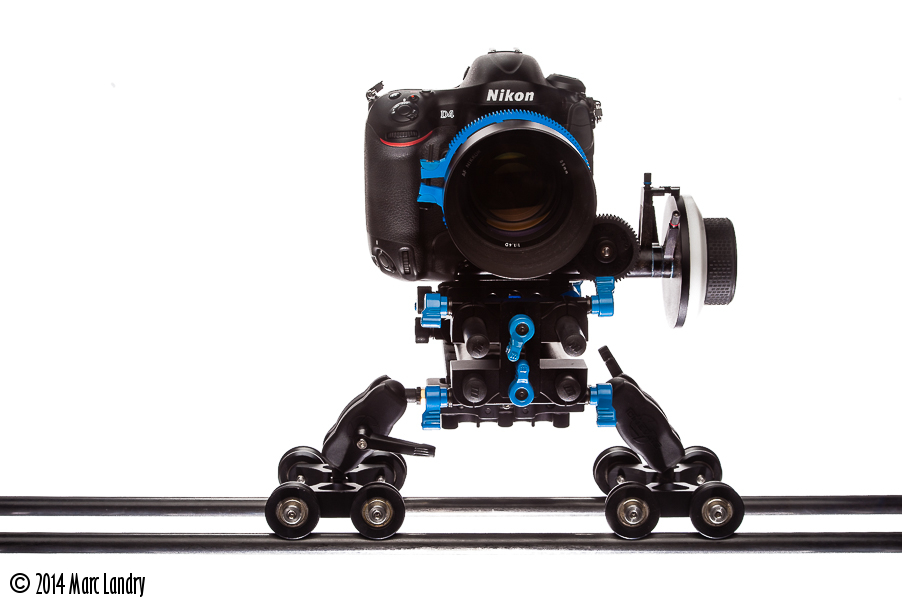Nikon D4 Review for Sports Photography
Nikon D4 Review
- Rating
The long awaited Nikon D4 is finally here. I couldn’t find an image of Nikonians rejoicing but trust me, we are. After much speculation, the new body hit showroom floors in late March this year. Rumors surrounding the body hypothesized that it was going to be what we now know is closer to the Nikon D800. A high megapixel, studio body aimed at shooters who are looking for resolutions comparable to a medium format camera. This is not something that interested me and I was relieved to see the D4’s definite spec when it was made available. It was more comparable to the D3’s lineage, which is what I was after. The D800 is amazing but not intended for a sports photographer like myself. Trying to push 36mp images through the pipeline to editors would be a major bottleneck. I have had billboards produced from my D3’s 12mp files without issue. I’ve never been asked for more megapixels and it’s not something that I am concerned about. This obviously mirrored the feedback other Nikon sports shooters had provided. I was looking for better image quality, advanced low-light capabilities and improved performance over my current D3, if that was even possible. The D4 delivered just that in this 16.2 megapixel body.
I ordered my D4 the day it was announced. I had been anticipating this body for a long time and couldn’t wait to get my hands on one. Other sports shooters I know had made the leap to the D3S a few years ago. I never made the upgrade however and continued to use my D3/D700 combo. I found these two bodies worked so seamlessly together that I opted to wait it out for the D4.
Shortly after the D4 announcement was made, I was invited by NPS to Nikon Canada’s offices for a private, hands-on presentation on the D4. I was not able to leave with any images from the pre-production body but I was able to handle it (read drool) and test some of its features. The body immediately felt comfortable in my hands and the AF speed seemed impressive, even given the limited testing environment. I was added to Nikon’s priority purchase program and all that was left was to count the sleeps.
My background is in video and I have wanted to make the leap to a video DSLR for a while. I am still using a Son HD camera for my video requirements . None of the current DSLR bodies from Nikon fit the bill for my needs and I didn’t want to sacrifice any photo capabilities for video functionality. The D4’s impressive video prowess combined with all the other added features make it the perfect body for my needs.
A lot of D3S shooters lit up forums expressing their discontent that the improvements in the D4 were not sufficient enough to justify the investment. Guys who lurk forums and read spec sheets are always good that way. While there is some truth to what they are saying, it’s unrealistic to assume that we would see the groundbreaking advances the D3 had in the very next iteration of a new body. The D3S was an incremental refinement to the D3, the D4 is a redesign. Of course the changes will seem less significant if you upgrade at every increment. There are many aspects of the current bodies that are dialed. I appreciate that Nikon kept those elements rather than change them simply for the sake of change. For me, this camera represents two additional stops of light, a much larger buffer, wi-fi camera control, uncompressed HD video, 10fps, AF capability up to F8 and refined ergonomics. I also think that the improvements in video are nearly, not quite, as impressive as the D3’s were with regard to stills at the time.
I received my D4 the night before shooting the Toronto Supercross. I was on my way home from scoping out the track when I got the call to pick it up. I barely had a chance to skim the manual and my first opportunity to click the shutter was at one of the most challenging events to photograph. I was immediately blown away by the speed and accuracy of the focusing module in the D4. The light in these stadiums is terrible. It looks bright enough to the human eye but, photography wise, it’s pretty bad. I found the focus acquisition to be lighting fast. Normally you look through the viewfinder, see your subject, focus and shoot. With the D4, it seemed effortless; the minute I looked at my subject I was locked-on (insert Top Gun quote here). Hunting, even in low light, was non-existent.
Shooting at ISO 6400 is often required to get a decent shutter speed at these races. Typical settings would be 1/1000, f/2.8 at ISO 3200-6400. I shot the Supercross at the same location the previous year and images at that exposure were “ok”. They were published and looked great but nothing compared to what I am seeing come out of the D4.
Here are two shots, one from each body. Even though they were shot with different lenses and apertures, the difference is quite apparent. Fact is, for the D3 image, I was maxed out. If I wanted 1/1000 for my shutter speed, I had to shoot wide open – I was already tapped at ISO 6400. Having that extra bit of breathing room to go up to ISO 12, 800 makes all the difference. Files are also cleaner across the board; ISO 6400 on the D4 is noticeably better than ISO 6400 on the D3 or D3S. That is the real benefit of ISO to an action photographer. We don’t need to compromise shutter and aperture in situations where we previously would have had to. It doesn’t replace fast glass but it gives us greater exposure options, which allows us control over how our image will look. It’s also very nice to have a base ISO of 100 again.
You can view the complete set of images from each race here: 2011 Supercross, 2012 Supercross
When setting up the camera initially, I simply matched it to the settings I used in my D3. There are several new menu items and configuration options but, for the most part, the nuts and bolts of the shooting menu are the same. I made one major gaffe in the setup however, which was turning it up to 11. I have a “turn it up to 11″ philosophy on life in general but in this case, it bit me in the butt. In my hasty perusing of the manual and subsequent setup of the body, I missed one very crucial caveat. When choosing the camera’s frame rate, I had the option of 10 or 11fps. I of course turned it up to 11, unwittingly muting my autofocus functionality in AF-C. At 11fps, the focusing system operates as though it is in AF-S. The result was that, when shooting a burst, the first image was tack sharp and all the others were out of focus. That’s exactly what it is supposed to happen with that setting, which is meant to shoot a sequence where the focal plan is constant. A prime example would be a skier jumping across the frame. Normally, you would lock off the focus in manual mode to accomplish this, which confirms that it is a logical trade off. This setting allows for an increased frame rate but at the expense of continuous autofocus. When trying to track a subject moving towards or away from you is when you will have the result I was getting. Let’s just say that I was sweating it big time; going through the images wondering if it was me, or worse, the body. I spoke to Nikon and the only other shooters I knew with this body and we were all stumped. It eventually dawned on me and reverting the fps back to 10 solved all my issues. The images are all tack sharp again now. Complete user error and best case scenario. Phew!
I only have about 3-4 shoots under my belt at this point on the still side and two on the video end. None of these shoots were meant to go “test” the camera. I am just going out and using it like I would any camera, trying the new features when I can. The stills from the camera look amazing and I see a definite improvement over my D3. Here are a few more images from recent shoots.
I like the revamped ergonomics and am slowly getting used to the joysticks. It’s starting to feel like Tetris back there. The slight tweak to the angle of the shutter release is very nice and I became accustomed to it instantly. Same goes for the little thumb perch now available when shooting vertical. The new 3.2″ LCD is amazing as are the back-lit buttons. The only thing I missed going from my D2X to D3 was the ability to see the sensors being used when in group dynamic. They used to be all lit up in the viewfinder and that was removed in the D3 series. This has been brought back and tiny red dots now surround the center point of the sensor cluster selected. I have yet to try the AF system with at the new F8 limit but am sure it will perform as advertised. Getting an 800mm field of view using a 400mm f/2.8 with a TC-20E and still being able to stop down, yes please! All these subtle improvements add up to a great camera.
Nikon tends to undersell and over-deliver on it’s products and this body is no exception. Nikon tests thoroughly and it’s very rare that something hits the market with an issue. I really respect that and it is why I have bought into this brand. Telling a client my camera isn’t ‘syncing’ high enough means nothing to them other than me not delivering. I need gear I can count on, day in and day out. The allure of a feature or slightly better spec rarely trumps function and reliability for me.
There were only two things that concerned me about the camera when it was announced. Those were the reduced battery life and the fact that it used two different card formats, CF and XQD. What I have found is that the battery actually seems to last almost as long as the EN-EL4A did and the benefits of the XQD card are worth the compromise. I do carry a spare battery with me now, something I didn’t used to do, but have had full days of shooting without issue. The exception being with video, which drains the battery big time. This was the case with the D3 in live view as well. I would have still preferred to see Nikon put in two XQD slots but I understand that they needed to do this in order to bridge the gap from current CF cards. This is still my only real beef with the D4 at this point. I’m sure the D4s will have dual XQD. As long as the XQD cards prove to be reliable, I will be happy to use them. They are crazy fast in the camera and capture via USB 3.0 is noticeably faster than my previous setup. Well worth it.
On the video side of things, I was also very impressed. There are a few things I would have liked to see added but none of them are deal breakers. With video DLSR being such a craze right now, there is surprisingly little information about a video setup for the D4. I did quite a bit of research and ended up with the following setup.
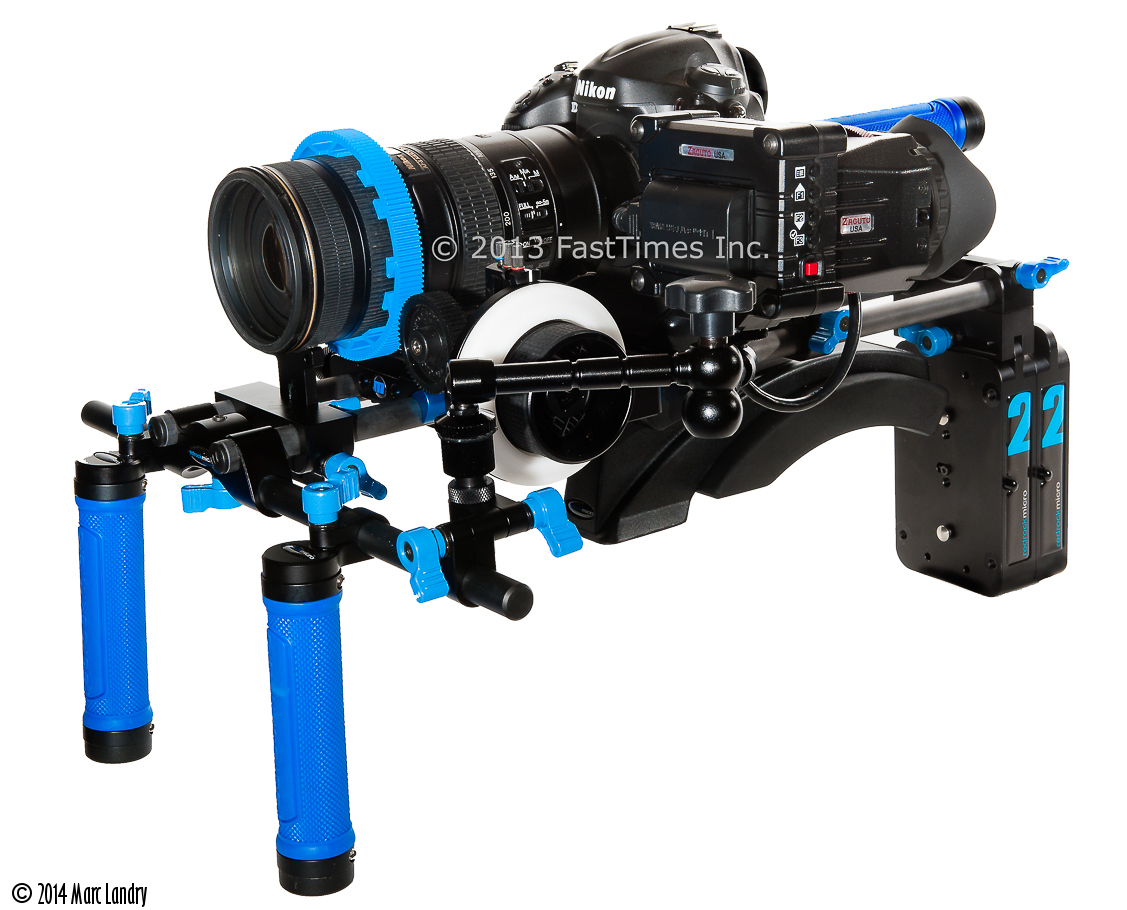
Nikon D4 with Redrock Micro, Field Cinema Bundle, lowBase for Tall-Bodied Cameras, microFollowFocus Black Professional Series and Zacuto Z-Finder EVF Pro
So far, I have enjoyed shooting video with the body. The video files look great, both 1080p and 720p. I have shot quite a bit over-cranked (60p) and the up-scaled image is still quite acceptable. Audio metering is wonderful and the clean HDMI is invaluable. Metering is a bit of a pain however and I find it odd that, out of all the display options available for the rear LCD, non of them help with focus or exposure. The tiny histogram is nice but, as everyone knows, the blinkies are where it’s at. A histogram will show you that something is clipped but it will not show you what is clipped. These are called zebra stripes in the video world and, to me, this is a must have. I need to know what is overexposed in order to make the correct call on the exposure. Blown out sky is not the same as a blown out face (please quote me on that). We are regularly making exposure compromises and need the tools to make the right choice. Focus peaking and a basic meter would also be a welcome addition. I would rather have a meter than the ability to change picture control for example. That is not something you need to do on the fly. After market external monitors and EVFs (electronic viewfinders) have these features but I would like to see them in-camera. I had purchased a Z-Finder EVF Pro which has all these options but returned it as I did not suit my needs in other areas, mostly ergonomics. I will likely get a loop for the rear LCD, which means I will not have these valuable exposure and focusing tools available. There are currently no loop options for a 3.2″ LCD.
The video below was shot with my D4, D600 and two GoPro cameras I wanted to do an exclusive D4 shoot but, at the time of this article, there simply aren’t any D4’s available. I also considered my D7000 but it does not capture 1080p at 30fps, which is disappointing as this would make a nice combo. 24fps is pretty much useless for action. This would be a really nice firmware upgrade in my opinion. I know many D7000 users are already asking for 60fps at 720p.
Darren Berrecloth, Mike Montgomery and Daniel Dhers ride at Joyride 150 from Marc Landry on Vimeo.
I will keep updating this review as I get more clicks under my belt but thought I would get this up so other sport photographers and videographers could get some information. Please feel free to post questions and comment below and I will stay on top of it the best I can.
Specifications
-
Lens MountNikon F bayonet mount
-
Effective Pixels16.2 million
-
Sensor Size36.0mm x 23.9mm
-
Image Sensor FormatFX
-
Image Sensor TypeCMOS
-
Total Pixels16.6 million
-
Dust-reduction systemImage sensor cleaning
Image Dust Off reference data (optional Capture NX 2 software required) -
Dust-Off Reference PhotoYes
-
Image Area (pixels)FX-format
(L) 4.928 × 3,280
(M) 3,696 × 2,456
(S) 2,464 × 1,640
1:2 format (30 x 20)
(L) 4,096 × 2,720
(M) 3,072 × 2,040
(S) 2,048 × 1,360
5:4 format (30 x 24)
(L) 4,096 × 3,280
(M) 3,072 × 2,456
(S) 2,048 × 1,640
DX-format
(L) 3,200 × 2,128
(M) 2,400 × 1,592
(S) 1,600 × 1,064 -
File Format Still ImagesJPEG: JPEG-Baseline Compliant; can be selected from Size Priority and Optimal Quality
JPEG: JPEG-Baseline Compliant with fine (approx 1:4), Normal (approx 1:8) or Basic (approx 1:16) Compression
NEF (RAW) + JPEG: Single Photograph Recorded in both NEF (RAW) and JPEG Formats
TIFF (RGB) -
Picture ControlLandscape
Monochrome
Neutral
Portrait
Standard
User-customizable Settings
Vivid -
Storage MediaCompactFlash© (CF) (Type I, compliant with UDMA)
XQD Type Memory -
Card Slot1 CompactFlash© (CF) card and 1 XQD memory type card
-
File SystemCompliant with DCF (Design Rule for Camera File System) 2.0
DPOF (Digital Print Order Format)
EXIF 2.3 (Exchangeable Image File Format for Digital Still Cameras)
PictBridge -
ViewfinderEye-level Pentaprism Single-Lens Reflex Viewfinder
-
Viewfinder Frame CoverageFX (36×24): 100% Horizontal and 100% Vertical Approx.
1.2x (30×20): 97% Horizontal and 97% Vertical Approx.
DX (24×16): 97% Horizontal and 97% Vertical Approx.
5:4 (30×24): 97% horizontal and 100% vertical Approx. -
Viewfinder Magnification0.70x Approx.
-
Viewfinder Eyepoint18mm (-1.0m¯¹)
-
Viewfinder Diopter AdjustmentBuilt-in diopter adjustment (-3 to +1 m¯¹)
-
Focusing ScreenType B BriteView Clear Matte Mark VIII with AF Area Brackets (grid lines can be displayed)
-
Reflex MirrorQuick-return type
-
Lens ApertureInstant-return type
-
Depth-of-field ControlYes
-
Lens Compatibility at a Glance***AF-S or AF lenses fully compatible
Metering with AI lenses -
Compatible LensesAF NIKKOR, including type G and D lenses (some restrictions apply to PC Micro-NIKKOR lenses and DX lenses (using DX 24 x 16 1.5x image area)
AI-P NIKKOR lenses, and non-CPU AI lenses (exposure modes A and M only) -
Shutter typeElectronically controlled vertical-travel focal-plane
-
Shutter Speed1/8000 to 30 sec.
-
Fastest Shutter Speed1/8000 sec.
-
Slowest Shutter Speed30 sec.
-
Flash Sync SpeedUp to 1/250 sec.
Synchronizes with shutter at 1/250s or slower -
Bulb Shutter SettingYes
-
Shutter Release ModesContinuous low-speed [CL] mode; 1-10 frames per second
Continuous high-speed [CH] mode; 10 frames per second; 11 with AE/AF locked on first frame
Mirror-up [Mup] mode
Quiet Shutter Release
Self-timer mode
Single-frame [S] mode -
Continuous Shooting OptionsFX-format
CH: Up to 10/11 frames per second
CL: Up to 10 frames per second
5:4 format
CH: Up to 10/11 frames per second
CL: Up to 10 frames per second
DX-format
CH: Up to 10/11 frames per second
CL: Up to 10 frames per second
1:2 format
CH: Up to 10/11 frames per second
CL: Up to 10 frames per second -
Top Continuous Shooting Speed at full resolution10 frames per second
11 frames per second (AE/AF Locked) -
Self-timer2, 5, 10, 20 sec. Timer duration electronically controlled
-
Exposure Metering SystemTTL exposure metering using 91,000-pixel RGB sensor
-
Metering MethodCenter-weighted: Weight of 75% given to 12mm circle in center of frame
Matrix: 3D color matrix metering III (type G and D lenses); color matrix metering III (other CPU lenses)
Spot: Meters 4mm circle (about 1.5% of frame) centered on selected focus point -
Metering Range-1 ± 20 EV (Matrix or center-weighted metering)
2 to 20 EV (spot metering) -
Exposure Meter CouplingCPU
AI -
Exposure ModesAperture-Priority (A)
Manual (M)
Programmed auto with flexible program (P)
Shutter-Priority (S) -
Exposure Compensation±5 EV in increments of 1/3, 1/2 or 1 EV
-
Exposure Bracketing2 to 9 frames in steps of 1/3, 1/2, 2/3 or 1 EV
-
Exposure LockYes
-
Mirror Lock UpYes
-
ISO SensitivityISO 100 – 12,800
Lo-1 (ISO 50)
Hi-4 (ISO 204,800) -
Lowest Standard ISO Sensitivity100
-
Highest Standard ISO Sensitivity12,800
-
Lowest Expanded ISO SensitivityLo-1 (ISO 50 equivalent)
-
Highest Expanded ISO SensitivityHI-4 (ISO 204,800 equivalent)
-
Expanded ISO Sensitivity OptionsHi-1 (ISO-25,600 equivalent) in 1/3, 1/2 or 1 EV
Hi-2, (ISO-51,200 equivalent), 1 EV
Hi-3, (ISO-102,400 equivalent), 1 EV
Hi-4 (ISO-204,800 equivalent) in 1 EV -
Long Exposure Noise ReductionYes
-
High ISO Noise ReductionLow
Normal
High
Off -
Active D-LightingAuto
Extra High
High
Normal
Low
On -
D-Lighting Bracketing2 frames using selected value for one frame
3–5 frames using preset values for all frames -
Single-point AF ModeYes
-
Dynamic AF ModeNumber of AF points: 9, 21, 51 and 51 (3D-tracking)
-
Auto-area AF ModeYes
-
Autofocus SystemNikon Advanced Multi-CAM 3500FX autofocus sensor module with TTL phase detection
-
Detection Range-2 to 19 EV (ISO 100, 68°F/20°C)
-
Lens ServoAutofocus (AF): Single-servo AF (AF-S); Continuous-servo AF (AF-C); predictive focus tracking activated automatically according to subject status
Manual focus (MF): Electronic rangefinder can be used -
AF-area mode9, 21 or 51 point Dynamic-area AF
Auto-area AF
Single-point AF
3D-tracking (51 points) -
Focus LockFocus can be locked by pressing AE-L/AF-L button
Focus can be locked by pressing shutter-release button halfway (single-servo AF) -
Focus ModesAuto AF-S/AF-C selection (AF-A)
Continuous-servo (AF-C)
Face-Priority AF available in Live View only and D-Movie only
Full-time Servo (AF-A) available in Live View only
Manual (M) with electronic rangefinder
Normal area
Single-servo AF (AF-S)
Wide area -
Maximum Autofocus Areas/Points51
-
Autofocus Sensitivity-2 to +19 EV (ISO 100, 20°C/68°F)
-
Autofocus Fine TuneYes
-
Flash Bracketing2 to 9 frames in steps of 1/3, 1/2, 2/3 or 1 EV
-
X-Sync Speed1/250
-
Top FP High Speed SyncUp to 1/8000
-
Flash ControlTTL: i-TTL flash control using 91,000-pixel RGB sensor are available with SB-910, SB-900, SB-800, SB-700, SB-600, or SB-400; i-TTL balanced fill-flash for digital SLR is used with matrix and center-weighted metering, standard i-TTL flash for digital SLR with spot metering
-
Flash Sync ModesAuto FP High-Speed Sync supported
Front-curtain sync (normal)
Rear-curtain sync
Red-Eye reduction
Red-Eye reduction with slow sync
Slow rear-curtain sync
Slow sync -
Flash Compensation-3 to +1 EV in increments of 1/3, 1/2 or 1 EV
-
Flash-ready indicatorLights when optional flash unit such as SB-910, SB-900, SB-700, SB-400, SB-R200 is fully charged
-
Accessory ShoeYes
-
Nikon Creative Lighting System (CLS)CLS Supported
-
Flash Sync TerminalYes
-
White BalanceAuto (2 types)
Choose color temperature (2500K–10000K)
Cloudy
Direct Sunlight
Flash
Fluorescent (7 types)
Incandescent
Preset manual (up to 4 values can be stored)
Shade -
White Balance Bracketing2 to 9 exposures in increments of 1, 2 or 3 EV
-
Live View ShootingPhotography Live View Mode
Movie Live View Mode -
Live View Lens servoAutofocus (AF): Single-servo AF (AF-S); full-time-servo AF (AF-F)
Manual focus (MF) -
Live View AF-area modeFace-priority AF
Wide-area AF
Normal-area AF
Subject-tracking AF -
Live View AutofocusContrast-detect AF anywhere in frame (camera selects focus point automatically when face-priority AF or subject-tracking AF is selected)
-
Movie MeteringTTL exposure metering using main image sensor
-
Movie Maximum recording time20 minutes at highest quality
29 minutes 59 seconds at normal quality -
Movie File FormatMOV
-
Movie Video CompressionH.264/MPEG-4 Advanced Video Coding
-
Movie Audio recording formatLinear PCM
-
MovieHD 1,920×1,080 / 30 fps
HD 1,920×1,080 / 24 fps
HD 1,280×720 / 30 fps
HD 1,280×720 / 60 fps -
Movie AudioBuilt-in microphone, monaural
External stereo microphone (optional) -
Monitor Size3.2 in. diagonal
-
Monitor Resolution921,000 Dots
-
Monitor TypeWide Viewing Angle TFT-LCD
-
Monitor Angle of View170-degree wide-viewing angle
-
Monitor AdjustmentsBrightness, 5 levels
-
Virtual Horizon Camera IndicatorYes
Also visible in LiveView Modes
Also visible in Viewfinder -
Playback FunctionsAuto Image Rotation
Full-Frame and Thumbnail (4, 9, or 72 images or calendar)
GPS data display
Highlights
Histogram Display
Image Comment
IPTC information embedding and display
Movie Playback
Movie Slideshow
Photo information
Playback with Zoom
Slideshow
Voice Memo -
In-Camera Image EditingColor Balance
D-Lighting
Distortion Control
Filter Effects
Image Overlay
Monochrome
NEF (RAW) Processing
Perspective Control
Red-Eye Correction
Resize
Side-by-Side Comparison
Straighten
Trim -
Image CommentYes
-
InterfaceHDMI output: Type C mini-pin HDMI connector
Headphone Connector
Hi-speed USB
NTSC
Stereo Microphone Input -
Wi-Fi FunctionalityWT-5A
WT-4A -
GPSGP-1 GPS unit
-
Save/Load Camera settingsYes
-
Total custom Settings58
-
My MenuYes with customization
-
Recent SettingsYes
-
Date, Time and Daylight Savings Time SettingsYes
-
World Time SettingYes
-
Battery / BatteriesEN-EL18 Lithium-ion Battery
-
Battery Life (shots per charge)2,600 shots per charge (Battery Life) (CIPA)
-
AC AdapterEH-6b AC Adapter
Requires EP-6 Power Supply Connector -
Battery ChargerMH-26 Quick Charger
-
Tripod Socket1/4 in.
-
Approx. Dimensions6.3 in. (160mm) x 6.2 in. (156.5mm) x 3.6 in. (90.5mm)
-
Approx. Weight
41.6 oz. (1180g)
camera body only -
Operating Environment0–40 °C (+32–104 °F)
-
Supplied SoftwareViewNX 2 CD-ROM
-
Supplied Accessories
- AN-DC7 strap
- EN-EL18 Rechargeable Li-ion Battery
- MH-26 Battery Charger
- UC-E15 USB Cable
- USB Cable Clip
- BF-1B Body Cap
- BS-2 Accessory Shoe Cover
- UF-2 Connector cover for stereo mini plug cable
- UF-1 Connector cover for USB cable
- Nikon View NX2 CD ROM
- Transmitter Utility CD
